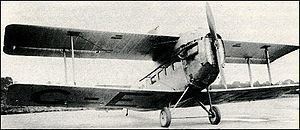Top speed 180 km/h Length 12 m Retired July 1928 Manufacturer Vickers | Wingspan 15 m Introduced August 1922 First flight April 1922 | |
 | ||
The Vickers Vulcan was a British single-engine biplane airliner of the 1920s built by Vickers Limited at Brooklands Aerodrome, Surrey. It carried eight passengers and a pilot.
Contents
Development
The Vickers Vulcan was designed by Rex Pierson of Vickers. It first flew in April 1922 at the hands of chief test pilot, S. Cockerell, at Brooklands Aerodrome in Surrey, UK.
The Vulcan was based on a civil version of the Vimy bomber, but featured many changes, including a much larger, taller fuselage and one, instead of two, Rolls-Royce Eagle VIII engines, the intention being low operating costs. The shape of its fuselage, as well as its flying characteristics, earned it the nickname "Flying Pig". The first delivery took place in August 1922, to Instone Air Line Ltd. Other operators included Imperial Airways and Qantas (however, the latter returned the aircraft as their performance was too poor for the company's needs). The last Vulcan flying was a Type 74 with Imperial Airways. It crashed in July 1928.
Variants
Operators
Individual aircraft
- G-EBBL; Type 61 - Prototype, first flew in April 1922, delivered to Instone Air Line in June 1922 as "City of Antwerp", sold to Imperial Airways, scrapped at Croydon Airport in May 1924.
- G-EBDH; Type 61 - Delivered to Instone Air Line in July 1922, accident at Oxted, Surrey, in 1922. returned to Vickers at Brooklands and withdrawn from use in 1923.
- G-EBEA; Type 61 - Delivered to Instone Air Line in July 1922 as "City of Brussels", returned to Vickers at Brooklands and withdrawn from use in 1923.
- G-EBEK; Type 63 - Delivered to Air Ministry at Martlesham Heath in November 1922 with Eagle IX for freighter trials, converted to passenger layout in 1925, scrapped in 1926.
- G-EBEM; Type 61 - Delivered to Douglas Vickers MP in September 1922, competed in King's Cup Air Race in September 1922, taking 7th place, disappeared off the coast of Italy in May 1926.
- G-EBES; Type 61 - Intended for Qantas, scrapped before completion.
- G-EBET; Type 61 - Delivered to Qantas in November 1922, returned, fate unknown but probably scrapped.
- G-EBFC; Type 74 - Delivered to Douglas Vickers MP January 1923, competed in King's Cup Air Race in 1923 (retired from the race), sold to Imperial Airways in January 1925, withdrawn from service in December 1925 and scrapped at Croydon in 1927.
- G-EBLB; Type 74 - Delivered to Imperial Airways in May 1925, crashed at Purley July 1928.
Specifications (Vulcan Type 74)
Data from Vickers Aircraft Since 1908
General characteristics
Performance
